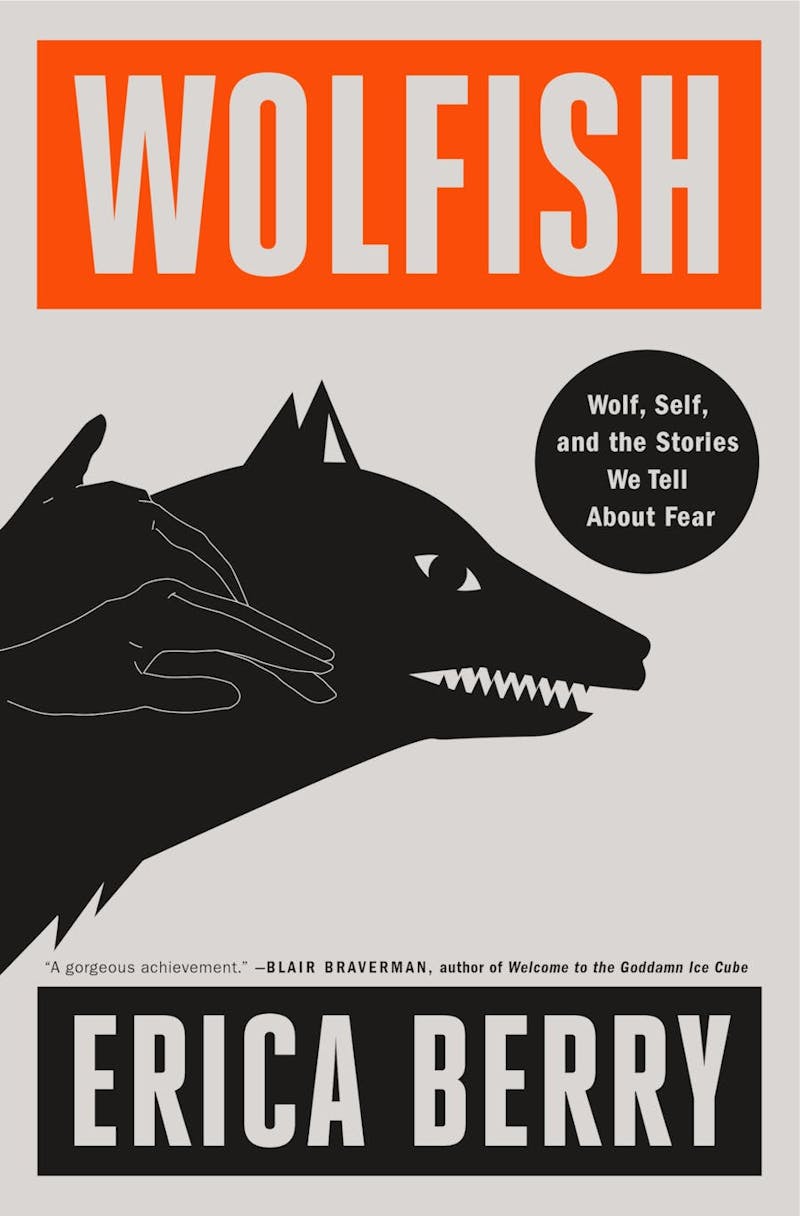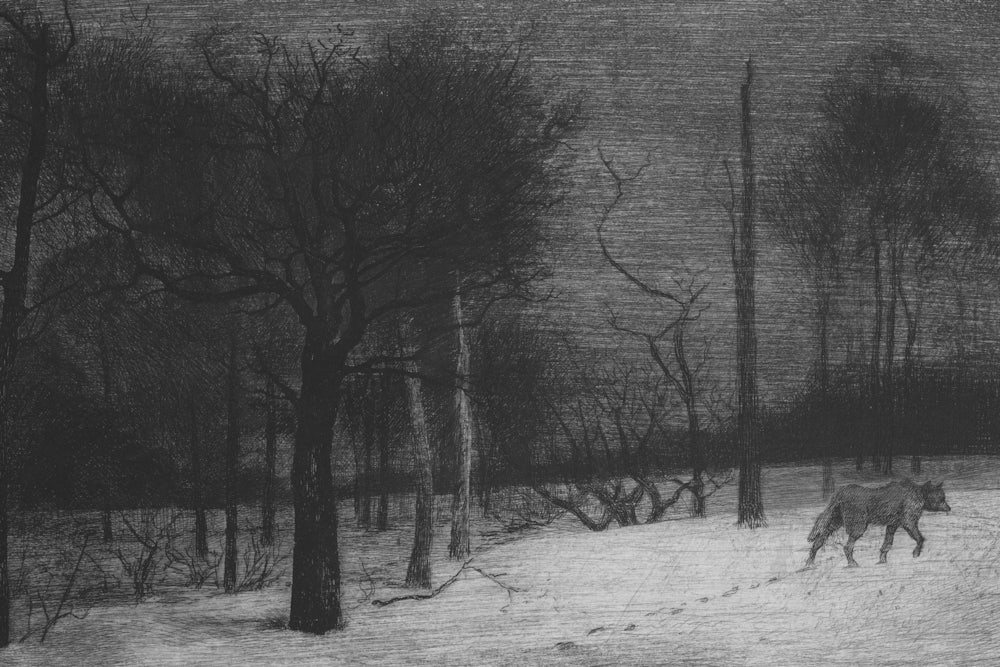What is it about the wolf—Canis lupus—that engenders such fascination, equal parts terror and love? Perhaps it has something to do with the fact that, like other apex predators, wolves do not display fear toward humans. While numerous websites will explain that yes, wolves are afraid of humans, wariness is not the same as fear, and avoiding humans is not the same as cowering before us. This lack of visceral, visible fear on the part of the wolf compels some of us to hunt and destroy it—not because it is a mortal threat (wolf attacks are so vanishingly rare as to be statistically insignificant), but because it refuses to submit (or even take much of an interest in us). Its threat to us, it seems, is primarily existential. For conservationists, this lack of fear engenders pity: The wolf is too stupid to fear the hunter’s gun or the poisoned trap and must be saved from its own inability to be afraid. It doesn’t know what’s good for it. Either way, we demand to be a part of the wolf’s life, to show it we have power over it.
In her debut book, Wolfish: Wolf, Self, and the Stories We Tell About Fear, Erica Berry writes of the manifold ways in which humans—herself included—have tried to write themselves into the story of the wolf. Her book follows a wolf named OR-7 (later nicknamed “Journey”), the first wolf to be sighted in western Oregon and Northern California since their reintroduction in the wild, quickly becoming famous for leaving his own pack and venturing out to lands uninhabited by his kind. But Wolfish is less invested in an actual wolf like OR-7 and more in the ways the animal we call Canis lupus is vastly different from the metaphoric construct that we call a “wolf”: “The wolf,” Berry writes early on, “is a piece of cultural taxidermy, fabricated by humans with parts gathered across time and space, and howling first and foremost in our heads.” Weaving together ecology and biology, history, anthropology, fairy tale, myth, and journalism, Wolfish sets out to pick apart these parts and examine them for what they are.

The wolf, in the twenty-first century, is a symbol of nature being back in “balance,” but the wolf is also the dangerous man you must be careful around, the standard-bearer for all would-be assailants awaiting in the dark to do harm to young women on their way to Grandma’s house. (It’s no accident, after all, that in the original sheet music for “Baby, It’s Cold Outside,” the parts are written in the score as being for “wolf” and “mouse.”)
Wolfish moves back and forth between these and other narratives like a wolf weaving through trees at night—assembling a story that’s ultimately about what we fear and why. “I became compelled by the wolf,” she explains at one point, “because I was intrigued by the investigation of a body that could be both feared and feared for, sometimes simultaneously.” Far more than a book about an animal, this is a book about how fear shapes the world. Attempting to free the animal from the myths and fears that envelop it, Berry also attempts to untangle her own relationship to fear, specifically fear of strange men. It is as though, if she can rid Canis lupus of the metaphors placed on it, she can rid herself of her own irrational fears, keeping only what’s useful.
Berry starts out with her own attempt to make the wolf her spiritual kin. “I had first seen headlines about [OR-7] leaving his family and starting to walk just months after I too had left home,” she writes. She did not pay much attention to the wolf to begin with. But surrounded by the hostility toward wolves in the rural Pacific Northwest (including T-shirts with pictures of wolves in crosshairs that read “Smoke a pack a day”), Berry becomes increasingly fascinated with the thorny relationship between humans, wolves, and conservation. Gradually OR-7, for Berry as for the general population, becomes a central protagonist in this story. She charts OR-7’s movements through the Pacific Northwest against her own, mapping wolf sightings onto the milestones of her early adulthood. A map and accompanying legend at the beginning of the book break each chapter into a sentence about wolves (“B-300, mother of OR-7, may have first crossed the Snake River into Oregon here, in Hell’s Canyon”) and a sentence about the author (“Erica begins a writing residency alone in a cabin in the woods on the Olympic Peninsula”).
But these two stories quickly diverge. For Berry’s memoir is one of growth and self-discovery, of attempting to reconcile her fear with the larger world. OR-7’s journey, however, follows no narrative arc. The wolf is not Joseph Campbell’s Hero; it moves only for food, to find a mate, to seek out new territory. Putting a GPS collar on an animal means we can track its movement, but it also creates the deceptive sense of an adventure leading somewhere. Tracing a wolf’s path through the Pacific Northwest invites a misplaced desire to make a story out of it, but while Berry is growing, OR-7 is simply moving.
As such, charting the wolf does not bring one closer to the animal. But what it does do for Berry is reveal the layers and webs of interconnectedness that we and the wolves share. After all, asserting our physical dominance over apex predators is one of the basic ways in which humans became “civilized,” whatever one makes of that word. Berry notes, for example, that her home state Oregon’s very first law was to create a tax to pay for wolf bounties. We hunt the wolf primarily because we like to keep open, unprotected fields of livestock for our own consumption, and we find it unneighborly when wolves help themselves to our sheep and cattle. Berry cites Brett Walker’s The Lost Wolves of Japan, where Walker describes how Japan’s attitude toward wolves didn’t turn distinctly negative until cattle farming ramped up in the twentieth century: “The main thing that had changed about Japan’s wolves was the economic world in which they existed. Capitalism, among other things, had made the wolf a wolf.” Unable to get into the mind of a wolf, she is nonetheless able to use the wolf to better understand the world around her: “Following OR-7’s life had not just made me care more about wolves, it had made me care about the long-lashed cows and the people who tended them, and especially the ecosystems we all shared.”
As for the actual wolves themselves: They remain elusive. While the book’s description promises that Wolfish charts “OR-7’s record-breaking journey out of the Wallowa Mountains,” OR-7 drops out of the narrative often, at one point for nearly a quarter of the book, as Berry goes to England to visit the UK Wolf Conservation Trust and then flashes back to a summer after graduating college that she spent in Sicily, where an ill-fated attempt to forage chard from the hillsides turns disastrous.
Without an actual wolf, the only thing we have left is fear itself. Berry describes herself as an almost perpetually fearful person, someone who was raised to fear wolves in all their forms even when they weren’t always a threat. As she explains: “When I began researching the wolf, I felt motivated by a handful of factors, but none was instinctual awe about the animal. Mostly I had become jumpy, and because I did not trust my fear, I was ashamed of it. It struck me as supremely unfair that in so many stories and sayings, the wolf had been made shorthand for the threat.” Berry documents her fear of men, of calling the cops on men, her fear of climate change and of a story of a coming earthquake that’s going to destroy the Pacific Northwest. The path to Grandma’s house, it seems, is beset on all sides by terrors.
It’s never made clear where this fear comes from, though it seems at times debilitating. Taking a trip to the town of Beenham, England, to study wolves, Berry instead becomes fixated on a single murder of a young woman in 1966 (her boyfriend at the time gently admonishes her: “To let yourself be afraid because of one night in 1966 is to make yourself a fool”). Without any origin for this jumpiness, it can be hard at times to evaluate Berry’s response. But it becomes clear that the real narrative of Wolfish is about a young woman who is repeatedly subjected to threatening experiences with men and cannot shake her own terror of such encounters.
A man on an uncrowded train who sits next to her and later leaves her a notebook with ominous insinuations (at the next stop he’s removed by law enforcement and detained). A man on the street in Minneapolis she half-smiles at follows her home and attempts a break-in; Berry calls 911 but insists on the phone that he may simply be having a medical episode (the cops take him away). A drunk man accosts her outside a bar, bear-hugging her and telling her she is someone else he once loved (a male bystander intervenes, assaulting the man and telling Berry to run, shouting after her, “I’m calling the cops”).
Again and again strange men beget fear, and fear begets the cops. And, inevitably, Berry finds herself afterward doubting her actions: Were these men truly a danger or merely undergoing some kind of mental health crisis—did they need to be met with aid instead of force? “I had feared for my own body,” she writes of one encounter, “but how easy it had been to endanger another’s too, someone I deemed, right or wrong, a threat.”
She distrusts her own fear, and she also distrusts this distrust. Wolfish maps out the ways in which patriarchy is in the business of gaslighting women, who are taught both not to feel safe and simultaneously to doubt that feeling. No sooner has she escaped a troubling situation than she’s back to questioning if she imagined the whole thing, disbelieving herself and finding herself disbelieved by others. (“Not only will you be alone in your fear, but you can also be alone in your belief of it.”) There is no easy solution to this problem (short of the dismantling of the patriarchy), and Berry does not offer one. Instead, her narrative inhabits that space between fear of others and a fear of her own fear.
Navigating her young adulthood as a white woman, Berry comes to understand that the long association of predatory men with “wolves” cuts both ways: Like wolves, they are not just feared but easily targeted by other men with guns and badges as soon as they’re deemed a threat. “That evening, stumbling over how to narrate the experience to a friend,” she writes of the potential break-in, “I realized that this was not a story about my being scared. It was a story about the power of my white female fear, a fear that could ignite the apparatus of a police state I had long ago come to doubt.” What Berry learns through the course of the book is how white women’s fear structures the world; as unwilling tools of a larger patriarchal structure, their vulnerability is regularly invoked to police the borders of what we call civilization.
The prose itself in Wolfish is brisk and essayistic, and makes for a compelling read. But among the many things Berry is afraid of, at times she is also afraid of her own voice. Throughout the book, Berry cites other essayists and poets (Cathy Park Hong, Elisa Washuta, and Carmen Maria Machado among them): Many of these quotations appear mainly as single sentences, without much elaboration or exposition, and seem designed mainly to shore up Berry’s own writing, as though she doesn’t quite have the confidence to bring her own lyrical flair to the page and needs to borrow.
Often, these quotes feel as though they’ve been put here out of Berry’s fear that, as a white woman, she needs to demonstrate her awareness of and debt to writers of color. But this backfires. For one, such quotes often end up being redundant: “The lesson of the game,” she writes of our dependency on fossil fuels, “is that burning resources always leads to collapse. The quarter drops. Someone always drinks what’s left. Our challenge is to learn to better take care of one another—human, animal, and plant—before we reach that point. As Alexis Pauline Gumbs asks in Undrowned: Black Feminist Lessons From Marine Mammals: “How can we listen across species, across extinction, across harm?” The invocation here is strange; in Undrowned, Gumbs spends pages attempting to wrestle with answers to this question, one that, to her, is intertwined with the legacy of slavery and the intergenerational trauma caused by racism. In Wolfish, the question is dropped like a generic, rhetorical call to action, and then Berry moves on.
It seems curious that Berry repeatedly quotes books explicitly about Blackness—not just Gumbs’s Undrowned but Isabel Wilkerson’s Caste: The Origins of Our Discontent, Claudia Rankine’s Just Us, and Tressie McMillan Cottom’s Thick, among others, often via quotes that are decontextualized and reduced to aphoristic asides—in a book relentlessly focused on the experience of being a white woman. What is a line from McMillan Cottom on the disbelief that Black women face when they’ve been assaulted (“What if your skin is too dark to show the bruises that the police often require to believe that you were abused?”) doing here, given that, to go by Berry’s telling, the police are always quick to believe her, even when she’s physically unharmed? When she again quotes McMillan Cottom on the potential harm that white women can do (“If I knew to be cautious of men, I did not learn early enough to be cautious of white women”), it is not in the context of potential harm that Berry does to Black women (or Black men—all her ambiguous assailants are white; there are virtually no Black people in Wolfish at all) but in the entirely accidental harm she does to a white German man. Seemingly afraid of her status as a white writer, Berry offers up Black writers (alongside other writers of color) as a counterbalance but, in the process, tries to strip them of context and make their words serve her own story.
But this is how fear works—it throws up any barricade it can think of, any defense against the beast at the door. In the process, it shapes the world in its own image. As a book written not just about fear but written in fear, Wolfish is a fascinating document illuminating how white women’s fear is used to make and unmake the world.
Meanwhile, OR-7’s GPS collar finally ran dead in 2015, and he was allowed to disappear back into the wilderness, his movements no longer tracked obsessively by human eyes. Last seen in 2019 and now presumed dead, by the end he was able to slip out of sight and be in nature not as a creation of human anxiety and aspiration, but simply as himself.






